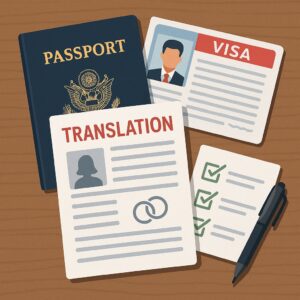
The visa application process can feel like a mountain of paperwork. Between gathering documents, scheduling appointments, and making sure everything is correct, it’s easy to overlook a critical detail: translations.
If any part of your documentation is in a language other than English, you need to provide clear, accurate translations. Not optional. Not later. This is a firm requirement for most U.S. visa categories, and missing it can hold things up or even lead to a denial.
To help keep your application on track, here are seven documents you should definitely have translated before submission.
1. Birth Certificate
A birth certificate is one of the most commonly required documents. It proves your identity, place of birth, and parentage. If it’s not in English, it must be translated in full, including stamps, signatures, and official notations.
Whether you’re applying for a family-based visa, a student visa, or anything else, expect to be asked for this. It’s one of the first things officials will look for.
2. Marriage Certificate
If you’re married and your visa category involves your spouse in any way, such as sponsoring them or being sponsored, your marriage certificate will need to be translated. This also applies if you were previously married and are now divorced. The U.S. government wants clear proof of relationship history.
Be sure the translation includes dates, names, issuing authority, and any official markings or seals.
3. Divorce or Death Certificates (if applicable)
Divorce decrees or death certificates are necessary to show the legal end of a previous marriage. These documents are especially important if your visa application involves a current spouse. USCIS and other immigration authorities require full disclosure and documentation of marital history.
Even if the original is straightforward, the English translation must be precise. Avoid summarised versions. Every part of the original should appear in the translation.
4. Academic Records and Diplomas
Planning to study or work in the U.S.? Your educational background will need to be verified through your transcripts and degrees. This includes secondary school, university diplomas, and professional qualifications.
A common mistake is assuming only the highest level of education needs translating. In reality, many visa types request a full academic record, especially for work or student applications.
Translations should include:
- Course names and grades
- Dates attended
- Name of institution and official seals
- Degree titles and honours, if any
Keep the format as close to the original as possible, but in clear, formal English.
5. Police Clearance Certificates
Some visa categories, especially immigrant and long-term visas, require you to provide a police clearance certificate or criminal background check from your home country or countries where you’ve lived.
This is where problems can arise. Many people assume these documents are already understood internationally, but even common phrases can cause confusion in another legal system. A clear, accurate translation is essential.
This is also a place where you should ensure the translation meets USCIS certified translation requirements, meaning it must be accompanied by a signed statement from the translator confirming accuracy and competence.
6. Bank Statements or Financial Proof
Some visa types ask for proof that you can support yourself financially while in the U.S. This could include:
- Bank statements
- Proof of employment
- Sponsorship letters
- Property ownership documents
If these are not in English, get them translated. While financial documents might seem straightforward, immigration officers need to understand every line without guessing. Dates, currencies, and names all need to be translated exactly as they appear.
Also, keep copies of both the original and the translation. They should always be submitted together.
7. Court Records or Legal Judgements
This applies only to some applicants, but it’s an important one. If you’ve been involved in legal proceedings, whether civil or criminal, you may need to disclose and provide records. That could include court rulings, charges, judgements, or even discharge papers. These documents help immigration authorities assess admissibility and eligibility.
They also require absolute clarity. A certified translation isn’t just expected, it’s often scrutinised. Officials will be looking closely at these documents, so even a minor mistake can delay things or trigger requests for more information.
One Missed Translation Can Stall the Entire Process
Missing or incorrect translations are a common reason for delays in the visa process. Don’t assume officials will accept a summary or a partial version. They need to see every part of the original document clearly reflected in English. That includes footnotes, stamps, marginal notes, and handwritten remarks.
Translations also need to follow a specific format. It’s not just about switching the language; it’s about ensuring the translated version holds up under legal and bureaucratic scrutiny.
USCIS and other immigration bodies are strict about this because they rely on those documents to make critical decisions. Even if your case is strong, an issue with your paperwork can put everything on hold.
Don’t Let Paperwork Undermine Your Plans
When it comes to a U.S. visa, every document matters. And every translated word can carry weight.
Prepare early. Check what’s needed. Get professional help with the translations if you need to. Most importantly, don’t treat this step as an afterthought. It’s not just about meeting a requirement. It’s about giving your application the best possible chance to succeed, without unnecessary hold-ups.
Whether you’re applying on your own, with family, or through an employer, getting your documents translated properly is one of the smartest moves you can make.




Leave a Reply